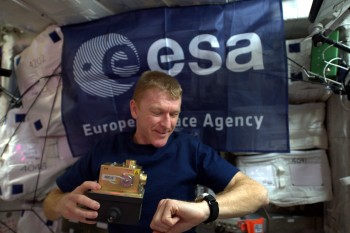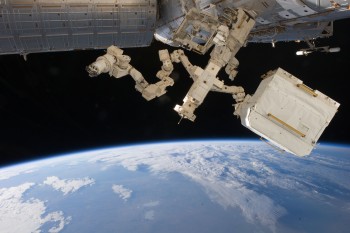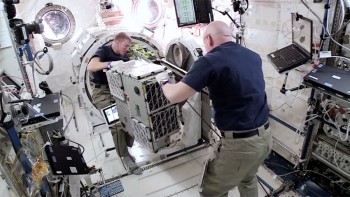Since Tim Peake’s spacewalk the British astronaut has been busy tidying up his spacesuit and tools and transferring cargo from the Cygnus supply spacecraft.
On 19 January Tim returned to normal operations after the intensive spacewalk. He prepared the first session of the Airway Monitoring experiment that will record nitrogen levels in his breathing. The next morning was spent on an eye experiment with more spacewalk cleanup in the afternoon.
The first Airway Monitoring session was done on 20 January in addition to Tim’s daily exercise routine, working on the Space Station’s warm water system, an emergency training and more eye exams using a fundoscope.
The Friday was spent on Airway Monitoring and Ocular Health experiments with the afternoon reserved for preparing the Japanese airlock with NASA and Canadian Space Agency Robotic Refueling Mission that is demonstrating the technology of refueling a satellite in orbit. If successful the Robotic Refueling Mission could drastically improve the time a satellite could function in space. The experiment returned inside the Space Station through Kibo’s airlock after Dextre, one of the Station’s robotic arms, placed it in the right place
Saturday was spent cleaning as usual with the Sunday given as free time for all the astronauts on the Space Station.
Monday saw Tim reviewing and preparing for a combustion session that is burning materials in space, transferring items from the Cygnus supply spacecraft and inserting a cartridge of metal samples into the Japanese Electrostatic Levitation Furnace.

Tim posted this image with the caption: “I like an accurate watch – this sensor will help our atomic clock be accurate to 1 second in 300 million years… now that’s precise.” Credits: ESA/NASA
On Tuesday Tim uninstalled a sensor in the Japanese laboratory and moved it to ESA’s Columbus laboratory where it will measure vibrations in the module to prepare for one of the most sensitive atomic clocks in the world. He also took part in NASA’s Fine Motor experiment looking at astronaut’s ability to conduct fine tasks in weightlessness and prepared the Japanese airlock to launch two student-built satellites from the Space Station.
The SSIKLOPS and LONESTAR satellites will demonstrate autonomous rendezvous and contact in space and are to be launched on Friday. Tim continued working on the satellite deployment on Wednesday and Thursday with Space Station commander Scott Kelly in addition to Cygnus cargo.
On 3 February another spacewalk is planned, this time with cosmonauts Yuri Malenchenko and Sergei Volkov. Tim’s activities for this spacewalk are minimal but he did lend a hand for a few hours over the week in preparation. The cosmonauts will install hardware and scientific experiments on the outside of the Station.
Watch the spacewalk live on NASA TV from 13:10 GMT.




Discussion: no comments